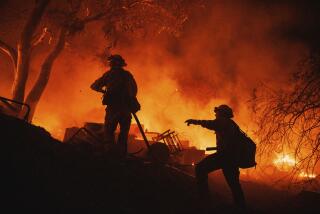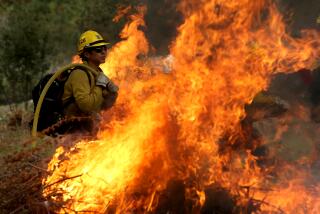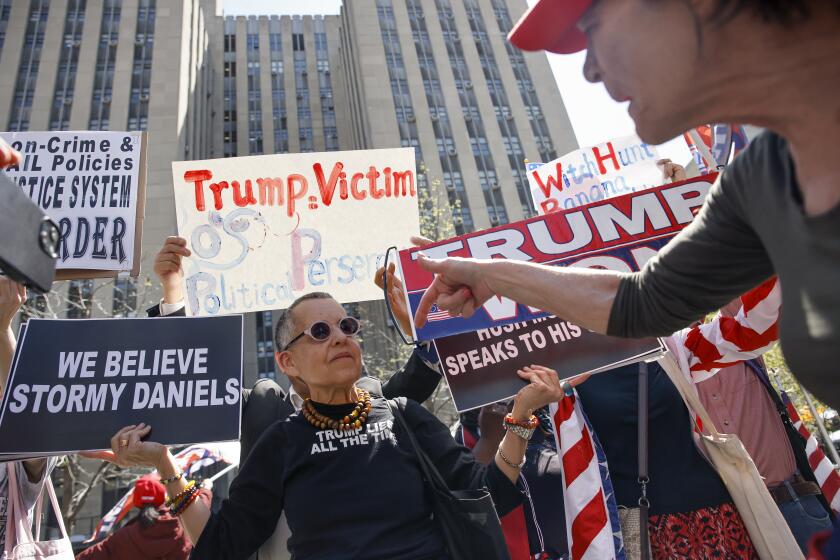The arsonist in our lifestyle
Aweek ago today, Malibu residents woke to discover that wildfire had broken out in the hills above the Pacific Coast Highway. By evening, nearly a dozen blazes were spreading across several counties, with flames igniting close to Poway, then Agua Dulce, Potrero, Los Olivos, Santiago Canyon and Ontario. For those of us who still enjoyed the luxury of a nearby TV through Monday night, the number of wildfires was being fixed, depending on your local station, at 15, 13, even 17. Hundreds of thousands of residents were ultimately evacuated from the fires’ paths.
How did this happen? Why did we go to bed on Saturday night a fireless constellation of communities, only to find ourselves swiftly interconnected by a web of smoke that stretched from the Mexican border to the Tejon Pass? Yes, we knew the possibility of fire was in the cards: the driest year on record, a Santa Ana-wind event on schedule. But how did things get out of hand so rapidly?
One clue could be found in the Griffith Park fire of May 8, the opening salvo of L.A.’s 2007 fire season. That day, Los Angeles Fire Department battalion chiefs witnessed fire behavior previously unknown so early in the season. What would have been described as “light winds” last week were ferrying embers off the fire line -- glowing cinders that lighted dozens of new blazes as far as a half a mile away, instead of the few hundred feet that had been typical. Parched vegetation, which in wetter years would have been too green to be ignited by an ember cooled after a half-mile flight, was exploding in flame. Fires create other fires, and the LAFD believed then that Griffith Park’s blaze was a window into the current Santa Ana season. If embers were already setting fire to the chaparral half a mile out in early May, what might they do in late October?
Now we know. But that’s only part of the explanation for what happened last week. After all, Malibu’s fire didn’t ignite Poway’s fire, and Running Springs didn’t ignite Stevenson Ranch. Something else had to be in play -- more than just the downed power lines that were initially suggested as a cause.
Forest fires are ignited by all kinds of things, but 98% are caused by human activity, and of those, a not-insignificant percentage are the result of arson. Following the terrible fire season of 2003, one study found that whenever a fire was burning through a Southern California national forest, there was a nearly 1-in-4 chance that another national forest would erupt in flames -- suggesting copycats at work, rather than just lightning, wind and bad luck.
California Department of Forestry statistics 2003 and 2004 show that almost 7% of the state’s wildfires were caused by arson. That adds up to 767 arson wildfires -- a number that would come as news, likely, to anyone. Imagine the effect that 767 arson forest fires in New Jersey would have on the national media -- but in a state as big as California, they’re barely noticed. What’s more, the department’s numbers probably understate the situation. Wildfire arson is a crime different from any other, and it is extremely difficult to identify. Immediately after a murder or a mugging, the perpetrator is still at the scene. But when an arsonist lights a wildfire -- a favorite method is to toss a cigarette tied to a bundle of matches and a steel washer out a car window -- he is often miles away before the brush erupts.
In his wake, a wildfire arsonist leaves the largest crime scene police agencies ever tackle. Unlike a torched warehouse, you can’t seal off 100,000 charred acres in yellow tape. Emergency crews have trampled the site, winds have blown through, and time has taken its toll. The motives that are most common when buildings are intentionally burned -- revenge, profit or extremism -- are less often at play in an arson wildfire, leaving the majority of them unsolved, if ever detected.
Forestry Department statistics for 2003-04 show 1,692 wildfires whose origin was never discovered. How many were arson? Ultimately, we may never know, just as we may never know the number of last week’s fires that were works of arson. Officials have already said that the large fire above Mission Viejo was intentionally set, as was a separate fire in Riverside County. But it would be foolish not to consider that others may have been arson as well.
Wildfire arsonists, like serial killers, are generally considered to be deviants. New York’s most famous arsonist may have been David Berkowitz, the “Son of Sam” killer, who claimed responsibility for about 2,000 fires. Southern California’s most notorious firebug is former Glendale arson investigator John Leonard Orr, who is serving a life sentence. Orr was 42 when he was arrested after a string of fires; several psychiatrists have characterized Berkowitz as a paranoid schizophrenic. For those reasons, neither man fits the typical profile of the arsonist, who is said by investigators and psychiatrists to be a young white male in his teens or 20s. He is angry, or a thrill-seeker who gets pleasure from violence and destruction, or someone looking for recognition by asserting himself on the world. (As these descriptions easily characterize young men everywhere, it’s plain we still don’t understand the arsonists in our midst.)
Steve Robles was 21 and fond of using an arson technique he’d picked up from a reality show called “L.A. Firefighters” when he was arrested in 1997 and linked to several fires. Robles, who had visited public schools dressed as “Sparky the Fire Dog” during fire-safety presentations, later described his arrest as any average young man would -- like something out of a “Cops” episode. He is serving an 18-year prison sentence.
As much as arsonists remain unmentioned by officials during multiple-fire events -- for fear of copycats -- they are relentlessly tracked afterward. Once a statutory crime against property, arson was permanently established as a violent crime by the federal Anti-Arson Act of 1982. On top of the tragic deaths in last week’s fires, you had only to gaze on some of the faces of the evacuees to see that these too were crimes against people, not property. Arsonists, however, are rarely caught, and convictions involving fire deaths are rarer still.
Even though our emergency agencies are now coordinating their efforts better than ever, our fire seasons keep growing worse, our conflagrations more terrible. Before last Sunday, the 19 largest and most costly wildfires in the state’s history had all occurred in the preceding quarter of a century. No doubt that number will now be upgraded. And while arson is an undeniable, unignorable part of what makes Southern California’s fire season as destructive as it is (along with drought and annual high winds), it is not the primary factor.
Only one statistic has kept pace with our explosion of wildfire numbers -- Southern California’s population. As it turns out, there is a direct link between population size and wildfire ignitions. While populations have doubled and then doubled again in Southern California, wildfire ignitions have grown at nearly the same rate. Because nearly all of our wildfires are caused by human activity -- overwhelmingly unintentional -- the arrival of millions more residents in the coming decades will ensure a lot more fire.
A report released last summer in the journal Ecological Applications -- and read by almost no one -- found that a landscape with an average of 45 humans per square kilometer was the perfect ecological system for creating the highest number of wildfire ignitions. Lower the population, and less activity exists to generate fires; raise it, and there is less wild land to burn.
Something you couldn’t help noticing in the helicopter pan shots last week were the number of roads, strung out loosely with houses, that wound through the glowing chaparral-and-conifer landscapes. The roads were everywhere, those on the furthest horizons waiting for construction starts. Gazing down on those houses, some aflame, lining roadways from Blue Jay to Ramona to Bouquet Canyon, even someone with a passing knowledge of the metric system could have concluded, “Yep -- looks like about 50 people per square kilometer to me.”
Maybe it is not just the arsonists but we ourselves who are stacking the odds against the best efforts of our own fire agencies. We are the accidental arsonists.
Dave Gardetta is a senior writer at Los Angeles magazine and the author of a cover story in the current issue about the May 8 fire in Griffith Park.
More to Read
A cure for the common opinion
Get thought-provoking perspectives with our weekly newsletter.
You may occasionally receive promotional content from the Los Angeles Times.






